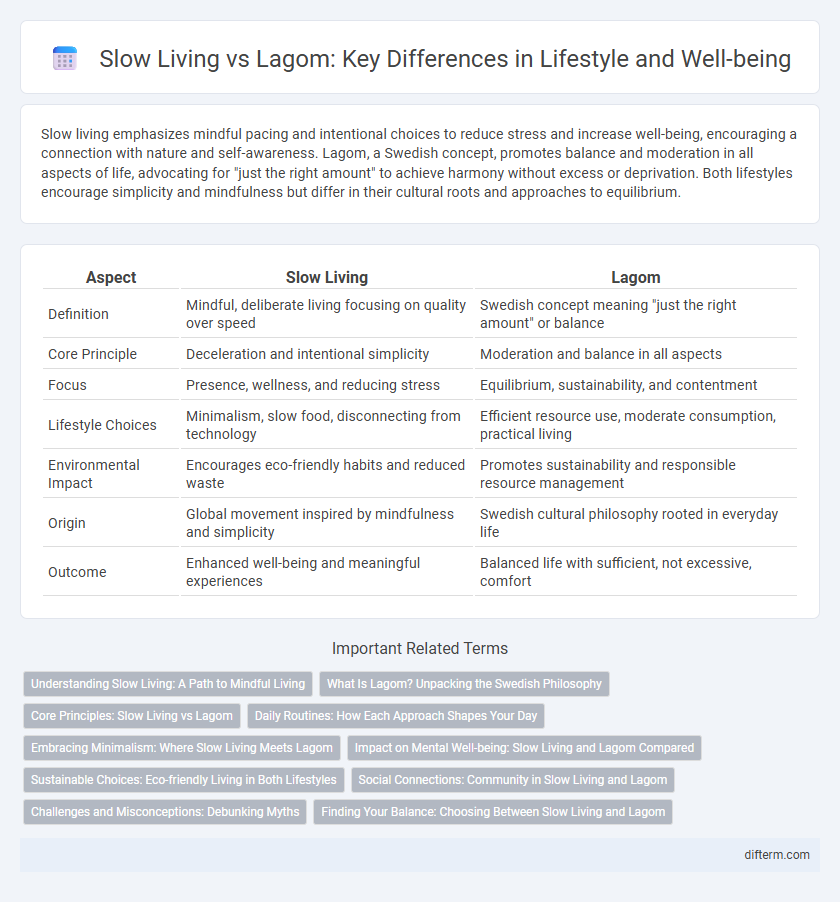Slow living emphasizes mindful pacing and intentional choices to reduce stress and increase well-being, encouraging a connection with nature and self-awareness. Lagom, a Swedish concept, promotes balance and moderation in all aspects of life, advocating for "just the right amount" to achieve harmony without excess or deprivation. Both lifestyles encourage simplicity and mindfulness but differ in their cultural roots and approaches to equilibrium.
Table of Comparison
| Aspect | Slow Living | Lagom |
|---|---|---|
| Definition | Mindful, deliberate living focusing on quality over speed | Swedish concept meaning "just the right amount" or balance |
| Core Principle | Deceleration and intentional simplicity | Moderation and balance in all aspects |
| Focus | Presence, wellness, and reducing stress | Equilibrium, sustainability, and contentment |
| Lifestyle Choices | Minimalism, slow food, disconnecting from technology | Efficient resource use, moderate consumption, practical living |
| Environmental Impact | Encourages eco-friendly habits and reduced waste | Promotes sustainability and responsible resource management |
| Origin | Global movement inspired by mindfulness and simplicity | Swedish cultural philosophy rooted in everyday life |
| Outcome | Enhanced well-being and meaningful experiences | Balanced life with sufficient, not excessive, comfort |
Understanding Slow Living: A Path to Mindful Living
Slow living encourages intentional pacing and mindfulness by emphasizing quality over quantity in daily activities, promoting well-being and reduced stress. Lagom, a Swedish concept meaning "just the right amount," aligns with slow living by advocating balance and moderation in consumption and lifestyle habits. Both philosophies foster a harmonious life through conscious choices and appreciation of the present moment.
What Is Lagom? Unpacking the Swedish Philosophy
Lagom, a Swedish philosophy meaning "just the right amount," emphasizes balance and moderation in daily life, promoting sustainability and well-being without excess. It encourages mindful consumption, work-life harmony, and appreciation of simplicity, contrasting with the slow living movement's focus on intentional time management and slowing down. Both philosophies prioritize quality over quantity, fostering a fulfilling lifestyle aligned with nature and personal contentment.
Core Principles: Slow Living vs Lagom
Slow living emphasizes mindfulness, intentionality, and reducing life's pace to foster well-being and presence. Lagom, a Swedish concept, centers on balance, moderation, and sufficiency to achieve harmony in daily life. Both philosophies advocate simplicity but differ in slow living's focus on time and experience, while lagom prioritizes equity and sustainability.
Daily Routines: How Each Approach Shapes Your Day
Slow living encourages mindfulness by prioritizing intentional activities and reducing multitasking in daily routines, fostering a calmer, more present lifestyle. Lagom emphasizes balanced daily habits by integrating moderation and practicality, promoting efficiency without excess. Both approaches shape your day by cultivating a sustainable rhythm that enhances well-being and reduces stress.
Embracing Minimalism: Where Slow Living Meets Lagom
Embracing minimalism in lifestyle choices highlights the intersection where slow living meets lagom, emphasizing intentional simplicity and balanced consumption. This approach encourages mindful daily habits, reducing excess while fostering contentment through sustainable and purposeful living. Prioritizing quality over quantity, minimalism within slow living and lagom cultivates well-being and environmental responsibility.
Impact on Mental Well-being: Slow Living and Lagom Compared
Slow living and Lagom both foster mental well-being by encouraging a balanced and mindful lifestyle, reducing stress and promoting contentment through intentional choices. Slow living emphasizes deceleration and deep engagement in daily activities, which enhances mental clarity and emotional resilience. Lagom, the Swedish philosophy of "just the right amount," cultivates mental harmony by advocating moderation and sustainable habits that prevent burnout and support long-term psychological health.
Sustainable Choices: Eco-friendly Living in Both Lifestyles
Slow living and lagom both emphasize sustainable choices by promoting eco-friendly living practices that reduce waste and encourage mindful consumption. Slow living advocates for intentional, quality experiences that minimize environmental impact, while lagom, rooted in Swedish culture, highlights balance and moderation in resource use. Both lifestyles prioritize sustainability through conscious decisions that support environmental preservation and long-term well-being.
Social Connections: Community in Slow Living and Lagom
Slow living emphasizes deep, meaningful social connections by fostering intentional community engagement and prioritizing quality over quantity in relationships. Lagom promotes balanced social interactions, encouraging harmonious community involvement that supports mutual well-being without excess. Both philosophies nurture a sense of belonging and purposeful connection, strengthening social bonds while maintaining personal equilibrium.
Challenges and Misconceptions: Debunking Myths
Slow living is often misunderstood as simply doing things at a slower pace, but it fundamentally emphasizes intentionality and mindfulness in daily routines. Lagom, the Swedish concept of "just the right amount," faces misconceptions as being minimalist or restrictive when it actually advocates balance and moderation across life aspects. Both lifestyles confront challenges in modern fast-paced societies where productivity is prized over well-being, making widespread adoption difficult despite their benefits for mental health and sustainability.
Finding Your Balance: Choosing Between Slow Living and Lagom
Slow living emphasizes mindfulness and intentional simplicity to enhance well-being, while Lagom, a Swedish concept, promotes balanced moderation in all aspects of life. Both approaches encourage sustainable habits and reduce stress but differ in cultural roots and practical application. Choosing between them depends on personal values and lifestyle goals, aiming for a harmonious balance that fosters contentment and resilience.
slow living vs lagom Infographic

 difterm.com
difterm.com